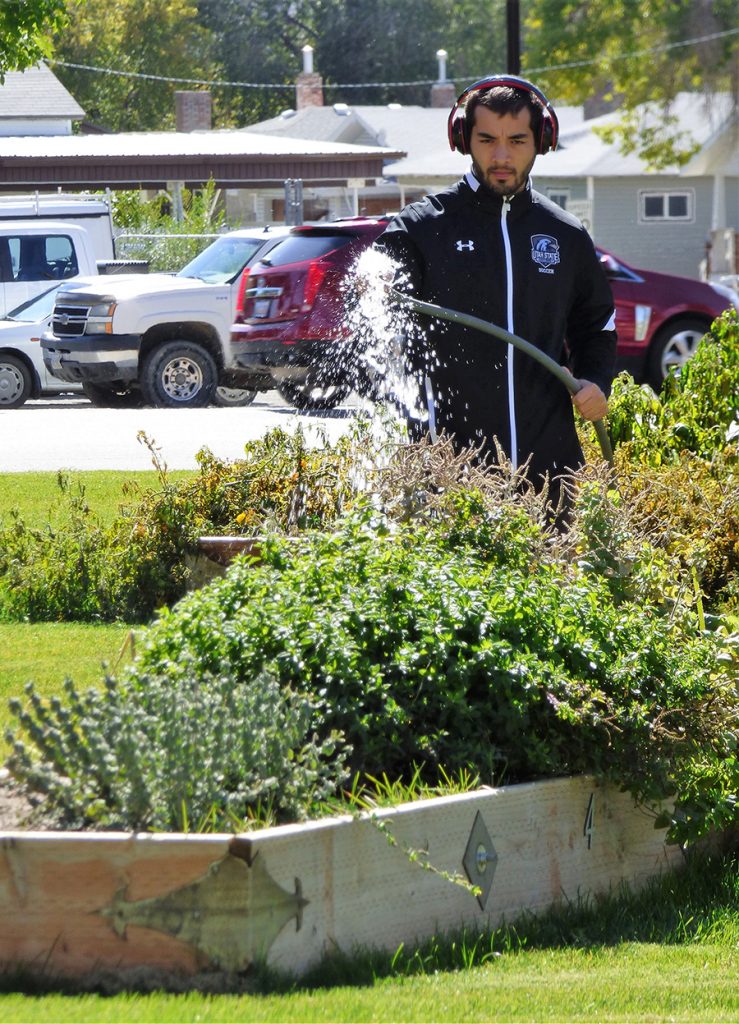Campus garden benefits local food bank

This archived article was written by: Scott Froehlich
In America, there are two extremes of the nutrition and health diet of the population. On one side, there are the ultra-health conscientious people who buy only all-natural and organic foods. On the other side, there are the people who throw caution to the wind and ingest fast food and other junk foods that are sodium-heavy and overly-sugary.
Somewhere between these two groups is a group of people who try to eat well; they buy the healthiest of food they can afford, despite a fixed income. Buried even further in this middle area, are the needy and less-fortunate who can’t afford regular meals, let alone healthy foods like fruits and vegetables.
To help curb this crisis locally, Vice Chancellor Gary Straquadine and Utah State University Eastern of Price created an on-campus community garden. In accordance with the Carbon County Food Bank, this community garden has helped provide fresh produce to those in need.
Utah State University Eastern began production of gardening boxes in April of 2015, for the purpose of starting a garden on the college’s campus. The nine boxes were installed on the southwest corner of the campus, where the old music building was located. The welding program had a hand in this building process, by creating intricate and decorative metal corners on each box, to prevent the wooden corners from coming apart. In the summer of 2015, the garden was ready to produce just in time for harvesting season.
The garden produces a wide variety of produce, with peppers (bell peppers, red/green, jalapenos, etc.), tomatoes, squash, garlic and onions being the hot commodities. These harvested fruits and vegetables produce anywhere from 40 to 60 pounds of food per week.
However, as with every garden, there are the occasional problems that gardeners run into that may jeopardize the crops. Hail can puncture leaves on plants, and can also hurt seedlings by damaging the soil. Bugs also harm the crops, and Straquadine recounted several occasions where insects posed problems for the garden. “We had a little problem with some of the squash and the squash bug… with whitefly on our Brussel sprouts. I love Brussel sprouts, and so [does] the whitefly,” Straquadine said.
It is worth noting that this garden isn’t organic; since everything is planted in such a condensed, high intensity situation, the gardeners use insecticides to combat the bug problem. With that in mind, Straquine said, “It could be [an organic garden] if you want to eat worms or whitefly.”
Aside from bugs and inclement weather, another worry regarding the garden is people stealing food. Initially, Straquadine had a discussion with other faculty about putting up signs and cameras to deter would-be thieves.
“I finally concluded, that if people want to steal from there, they are probably hungry. If they are stealing my tomatoes to throw at the principal’s car at the high school, I’d probably be upset. Most of the time, I think people are probably stealing to take it home and eat it. [While] they are stealing from poor people…they are probably poor people themselves.”
Straquadine hopes that this garden will raise awareness of the problems that some people have with feeding their families. “The food is produced in the garden to bring the people who like food and gardening together into a community. The idea is to get people talking about the fact that there’s food issues, even in America [and] rural America, of all places,” Straquadine said.
In addition to spreading awareness, the volunteers over the past two summers have expressed sincere joy when describing their time spent in the garden. Kainå Elias, a sophomore who also plays soccer for the Eagles, spent the past summer working i the garden, and reflected on his experience.
“Gary, offered me a job to help in the engineer lab… [at the] beginning of the summer. He told me he would like some help with the garden as well, as part of the job and I said, ‘Sure, why not?’ Most of [my friends] were gone…plus there were no classes,” Elias said. He said some of the biggest things that he took from his time in the garden. Elias said that he enjoyed, “looking at the seeds in the beginning [of the season], and realizing that they grow really fast.
“If you put some effort [into it], anyone can have a garden and eat really healthy…and you may even save money,” Elias said.
Straquandine encourages all students to come volunteer at the campus-community garden, as well as eat more healthy foods. “The more you can see food on this campus growing, the more you’ll probably be open to eating it, rather than the instantaneous crappy food that they sell at places… we need to eat more fresh food,” he said.
Those interested in volunteering with Straquadine at the community garden can reach him by either calling his office at (435)-613-5294, emailing him at [email protected] or stopping by the Reeves Building administrative suite. Don’t worry about having experience because Staquadine says, “No green thumb required.”




